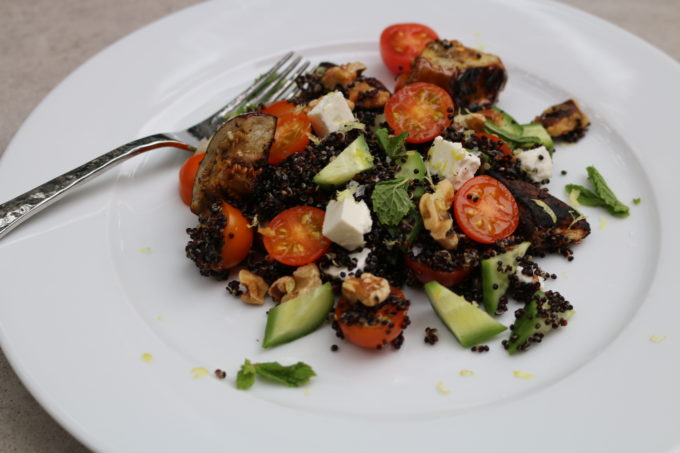
I haven’t always loved quinoa. Too many dishes I’ve tried featuring it are a little mushy, a little bland, just generally not worth eating. Why does everyone else go crazy for it? The only answer, I’ve deduced, is quinoa’s strong health halo. It’s as if people don’t necessarily care if it tastes good because they’re more concentrated on the fact it’s good for them.
To each his own but I’m not one of those people. There is not a food in the world I would eat just because its healthy. Why when there are so many delicious alternatives? However, after being forced to get to know the grain (or, to be more accurate, the seed) by city clients, Copper Beech customers, friends, basically the rest of the world, I’m a convert.
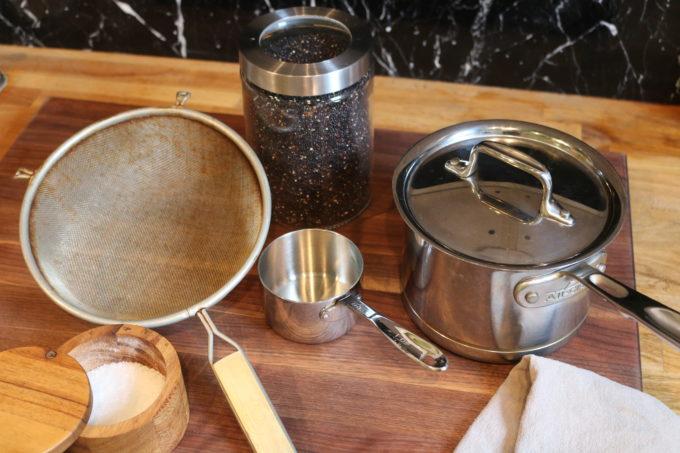
My conversion was gradual. It began by applying a little common culinary sense and culminated soon after I hired Charlotte.
Cooking directions on most boxes of quinoa reads as follows: “Place 1 cup (whatever brand) quinoa and 2 cups water in a 1 ½ quart saucepan and bring to a boil. Reduce to a simmer, cover and cook until all water is absorbed, about 15 minutes.” These instructions yields wet, overcooked quinoa, with zero texture and little flavor. If the dishes I’ve tried while dining out are any indication, the majority of people follow these instructions.
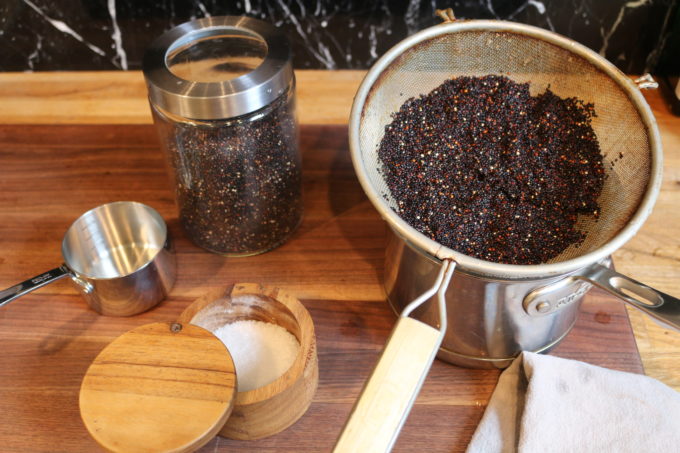
If I wanted it to be less wet, why not add less water to begin with? Overtime I reduced my quinoa:water ratio to 1:1.5 and obviously, obviously, added a big pinch of salt. (Why wouldn’t boxed directions mention that?!)
I found I liked it even more and had more control if I left the top off the pot entirely while the quinoa simmered away. I could easily adjust the heat to speed things up or slow things down. If necessary, I could drain the quinoa as soon as I saw the germ ring along the outside of the grain or add a few tablespoons of water if it all evaporated before the quinoa was ready. To ensure the quinoa remained as fluffable (that’s not a word, but it should be) as possible, I’d then place a clean kitchen towel over the saucepot and top it with a lid. This allowed the quinoa to steam for a few minutes while the towel absorbed excess liquid. The resulting quinoa was fluffy and flavorful, if not a little clumpy.
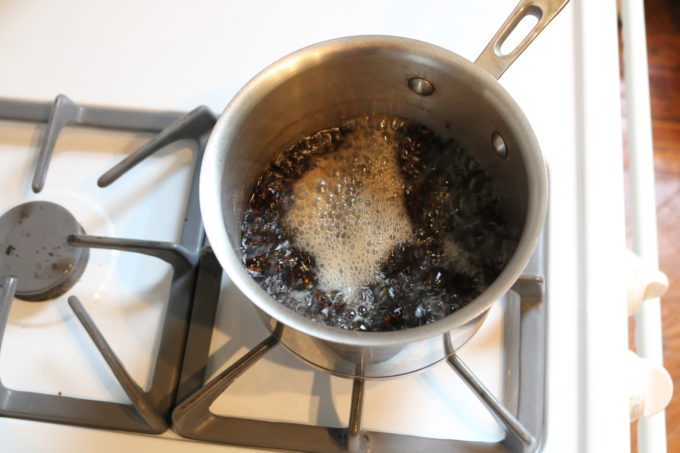
That’s when Charlotte sealed the deal. While “training” her during her first week with What We Eat back in January, I assigned her the task of a quinoa salad. I watched with one eye as she first rinsed the quinoa, then added it to a saucepan. Of course, I jumped in to explain how “we cook quinoa” (I’m so obnoxious) explaining to her that rinsing it first was unnecessary. Being the sweet person she is, she accepted this without question and continued as instructed.
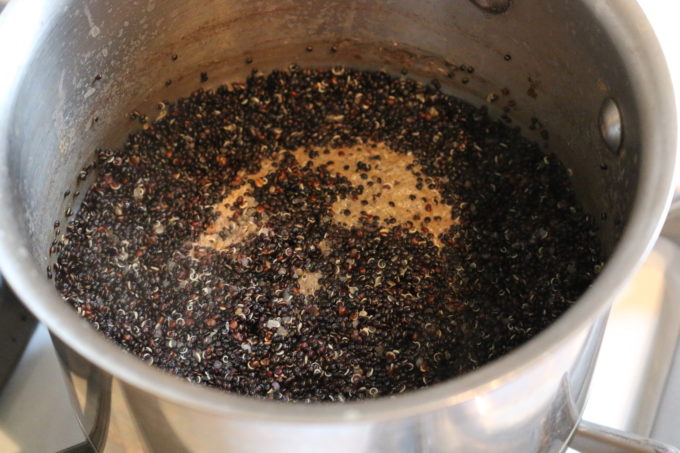
But guess what? Char’s rinsed quinoa prepared with our previously adaptions was perfect. Fluffy, flavorful, with just the right amount of pop and not at all clumpy. Not above admitting my faults, I quickly accepted this initial rinse and have never looked back.
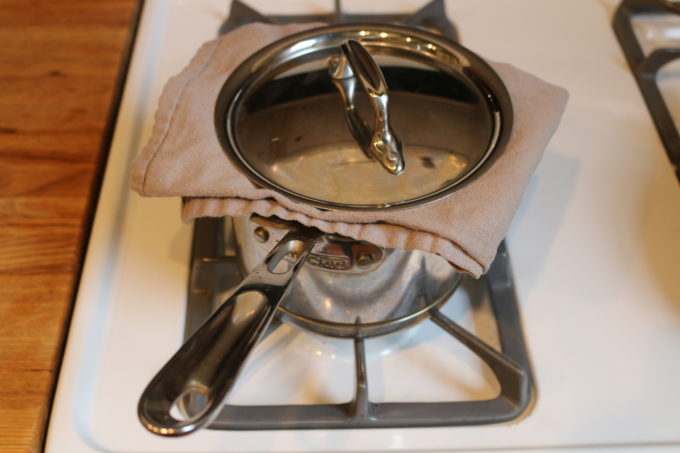
Now I happily prepare countless quinoa dishes without feeling like my clients (or I) are trading pleasure for health. So, if like me you’ve been anti-quinoa, try this method and experiment with a few of our favorite add-in variations below. Who knows? Maybe you can learn to love quinoa too.
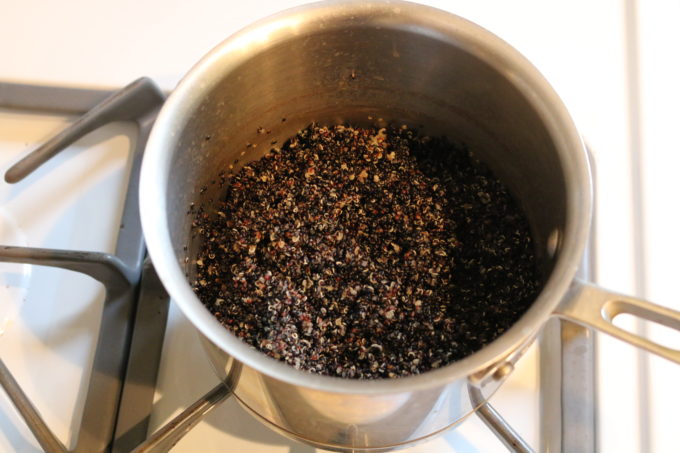
How What We Eat Cooks Quinoa
Scale as necessary and assume 1 cup quinoa feeds about 2-4 people.
Ingredients
1 cup quinoa
1.5 cups water
Pinch of salt
First, rinse quinoa in a fine-mesh strainer, moving the grains around a little bit with your hands to make sure you are removing any excess starch. Next, transfer quinoa to a pot so it comes up to no less than 1.5 inches in depth and no more than say 3.5 inches. The latter will only happen if you are making a large batch. If you use a pot that’s too big, the water will evaporate before the quinoa has time to cook. If you use a pot that’s too small, the quinoa at the bottom will overcook by the time the quinoa at the top sprouts.
Next, add in water so that its a 1:1.5 ratio of quinoa to water and a generous pinch of salt (more with more quinoa). Put on the stovetop over high heat and bring to a boil. Once boiling, reduce to a simmer. No need to stir it at all during this entire process. Let the quinoa do its thing for about 5 minutes then after that, begin to watch it more closely. Can you see the quinoa begin to “sprout” little curly cues? If so and there is a good amount of water left, turn up the heat so it evaporates more quickly. Does the quinoa still look exactly the same as when you started it while a good amount of water has already evaporated? Turn down the heat to slow things down. Ideally, the water will be absorbed/evaporated at the exact time the quinoa is done. If there is water left but the majority of curly cues are showing, drain it in the fine mesh strainer and return it to the pot. If it needs more time, water, add water by the tablespoon full until its done. It’s generally done anywhere between 10-18 minutes (longer times are more common with black and red quinoa).
When you are nearly happy with what you see–the quinoa will be showing a good amount of curly cues but not look water logged and all water is evaporated–place a clean kitchen cloth over the pot and top it with the pot top. Again, do not stir it. Allow to rest and steam for 5 minutes. After that, remove the top and cloth and fluff gently with a fork. It’s ready!
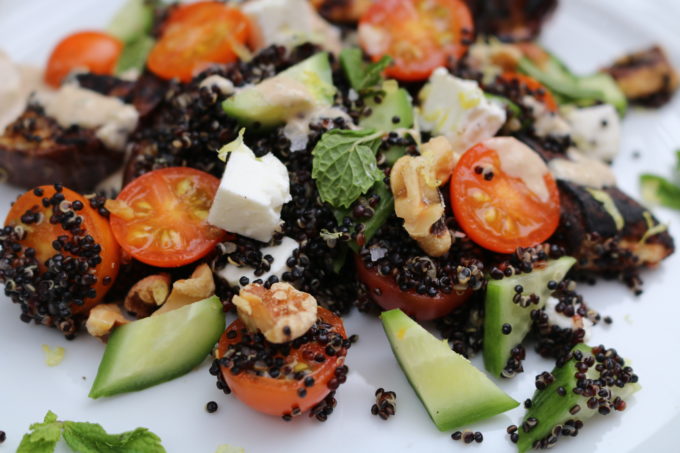
Quinoa Add-ins
- Pictured above: Lemon zest/juice, olive oil, crumbled feta, cherry tomatoes, cucumber, red onion or scallions, roasted eggplant, toasted walnuts and mint
- Lemon juice/zest, olive oil, sliced apples, dried cranberries, toasted almonds or hazelnuts, mint
- Lemon juice/zest, roasted winter squash, dates, toasted almonds, crumbled goat cheese, scallions, mint
- Lime zest/juice, olive oil, corn, cherry, crumbled feta, toasted pepitas, scallions, cilantro
- Lemon juice/zest, olive oil, roasted mushrooms, toasted hazelnuts, shaved parmesan, basil and/or parsley
- Orange juice/zest, white wine vinegar, olive oil, steamed beets, shallots, crumbled goat cheese, toasted almonds or hazelnuts, mint
- Lemon juice/zest, dijon mustard, olive oil, blanched peas/sugar snaps/green beans, shallots, basil, toasted hazelnuts
- Sky is seriously the limit here guys. Come up with your own combination using what’s available and share your creations with us here!